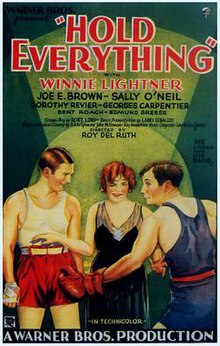Hold Everything (film)
| Hold Everything | |
|---|---|
 theatrical release poster | |
| Directed by | Roy Del Ruth |
| Written by | Robert Lord |
| Based on | play by Buddy G. DeSylva, Ray Henderson, and John McGowan |
| Starring | Winnie Lightner Joe E. Brown |
| Cinematography | Devereaux Jennings (Technicolor) |
| Edited by | William Holmes |
| Music by | Joseph Burke Ray Henderson |
Production company | |
| Distributed by | Warner Bros. |
Release date |
|
Running time | 78 minutes |
| Country | United States |
| Language | English |
| Budget | $491,000[1] |
| Box office | $1,333,000[1] |
Hold Everything is a 1930 American pre-Code film. This musical comedy film was photographed entirely in early two-color Technicolor. The first all Technicolor musical comedy film was "On With the Show" in 1929. "Hold Everything" was adapted from the DeSylva-Brown-Henderson Broadway musical of the same name that had served as a vehicle for Bert Lahr and starred Winnie Lightner and Joe E. Brown as the comedy duo. The romantic subplot was played by Georges Carpentier and Sally O'Neil. Only three songs from the stage show remained: "You're the Cream in My Coffee", "To Know You Is To Love You", and "Don't Hold Everything". New songs were written for the film by Al Dubin and Joe Burke, including one that became a hit in 1930: "When The Little Red Roses Get The Blues For You". The songs in the film were played by Abe Lyman and his orchestra.
Plot
[edit]Brown plays Gink Schiner, a third-rate fighter who is at the same training camp as Georges La Verne (played by Georges Carpentier), a contender for the heavyweight championship. Although he needs to be concentrating all of his energies on the upcoming bout, Georges keeps getting distracted: Norine Lloyd, a society dame, has a distinct interest in him, but the interest is strictly one-sided. Georges prefers Sue, an old buddy and confidante. Gink has woman trouble of his own, as his flirtations do not sit at all well with Toots (played by Winnie Lightner), his erstwhile girlfriend.
More trouble arrives when Larkin, manager of current heavyweight champ Bob Morgan, appears at the camp with the goal of fixing the fight. He is sent packing, after which he attempts to slip a Mickey Finn to the challenger—a plan which goes awry when Gink switches the drinks. Meanwhile, Gink, who is fighting in a preliminary in advance of the big fight, actually wins. Things don't look so bright for Georges, who initially gets the worst of it in his encounter with Morgan, but who eventually comes out on top.
Cast
[edit]- Joe E. Brown as Gink Schiner
- Winnie Lightner as Toots Breen
- Sally O'Neil as Sue Burke
- Georges Carpentier as Georges La Verne
- Edmund Breese as Pop O'Keefe
- Bert Roach as Nosey Bartlett
- Dorothy Revier as Norine Lloyd
- Jack Curtis as Murph Levy
- Tony Stabenau as Bob Morgan
- Lew Harvey as Dan Larkin
- Abe Lyman as Orchestra Leader
Release
[edit]In 1930, this was the first film shown at the newly opened Warner Bros. Hollywood Theatre, a luxurious New York City movie palace specifically designed to showcase its then-revolutionary Vitaphone sound films. The theatre later became a legitimate Broadway venue, the Mark Hellinger Theatre, and is now the home of the Times Square Church.[2]
Box office
[edit]According to Warner Bros records the film earned $1,018,000 domestically and $315,000 foreign.[1]
Preservation status
[edit]The sound discs survive, but the visuals are lost. The George Eastman Museum 2015 book The Dawn of Technicolor, 1915-1935 mistakenly reported that the Library of Congress possesses a black and white print, but that is not true. No color print is known to exist as of 2024.[3]
See also
[edit]References
[edit]- ^ a b c Warner Bros financial information in The William Schaefer Ledger. See Appendix 1, Historical Journal of Film, Radio and Television, (1995) 15:sup1, 1-31 p 10 doi:10.1080/01439689508604551
- ^ Morrison, William (1999). Broadway Theatres: History and Architecture (trade paperback). Dover Books on Architecture. Mineola, New York: Dover Publications. pp. 162–163. ISBN 0-486-40244-4.
- ^ The Dawn of Technicolor, 1915–1935, c.2015 George Eastman Museum
External links
[edit]- 1930 films
- 1930s color films
- 1930s sports comedy films
- American boxing films
- Warner Bros. films
- 1930s English-language films
- Films directed by Roy Del Ruth
- 1930s rediscovered films
- American musical comedy films
- 1930 musical comedy films
- Early color films
- Films with screenplays by Robert Lord (screenwriter)
- American sports comedy films
- Rediscovered American films
- 1930s American films
- English-language musical comedy films
- English-language sports comedy films
